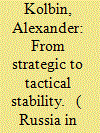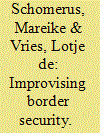| Srl | Item |
| 1 |
ID:
157244


|
|
|
|
|
| Summary/Abstract |
Arms control helped maintain strategic stability during the Cold War. However, after the end of the Cold War, the concept of strategic stability has ceased to be a hostage to the Soviet-U.S. confrontation and the nuclear arms race between the two countries. This concept now includes additional international players and security threats. As a result, Russia and the U.S. have different views on factors that affect strategic stability, and the boundaries of this concept have become blurred. Gone is a common understanding of strategic stability, along with a general understanding of the need for arms control as a factor for this stability. In Russian-U.S. relations stability should be reset at several tactical levels, or at least the parties should implement the idea of "tactical stability" as a new conceptual basis for bilateral arms control.
|
|
|
|
|
|
|
|
|
|
|
|
|
|
|
|
| 2 |
ID:
132339


|
|
|
|
|
| Publication |
2014.
|
| Summary/Abstract |
This article compares two cases of securitization along South Sudan's border with the Democratic Republic of the Congo. By comparing how a security concern - the presence of the Lord's Resistance Army - was interpreted and responded to, the article shows that border security practices in two borderscapes are improvised, contradictory and contested, and serve to establish authority rather than actually securing the border. This is apparent on three levels: (a) through the multiplicity of security actors vying for authority; (b) in how they interpret security concerns; and (c) in terms of what practice follows. The article argues that by allowing authority at the border to be taken by actors that are not under direct control of the central government, the South Sudanese state is developing as one that controls parts of the country in absentia, either by granting discretionary powers to low-level government authorities at the border or through tactical neglect. Processes of securitization by both state and non-state actors in the borderland are largely disconnected from the South Sudanese central government, which does not claim authority over this border and thus seemingly does not consider the lack of security for its citizens, and the parallel authorities, as a threat to central stability.
|
|
|
|
|
|
|
|
|
|
|
|
|
|
|
|